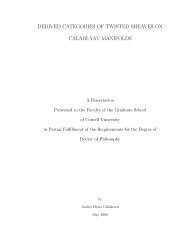Math 320 - Fall 2010 HW #7 Selected Solutions Problem 5.1.32 Let ...
Math 320 - Fall 2010 HW #7 Selected Solutions Problem 5.1.32 Let ...
Math 320 - Fall 2010 HW #7 Selected Solutions Problem 5.1.32 Let ...
Create successful ePaper yourself
Turn your PDF publications into a flip-book with our unique Google optimized e-Paper software.
our techniques from earlier in the semester.<br />
dW −B(x)<br />
=<br />
W A(x) dx<br />
� �<br />
dW B(x)<br />
= −<br />
W A(x) dx<br />
�<br />
B(x)<br />
ln |W | + C1 = −<br />
A(x) dx<br />
�<br />
B(x)<br />
ln |W | = − dx + C<br />
A(x)<br />
Now, first assume that W > 0. Then we have ln |W | = ln W , and then, taking exp of both sides, and<br />
setting K = eC , we obtain<br />
� �<br />
B(x)<br />
W = exp −<br />
A(x) dx<br />
�<br />
e C � �<br />
B(x)<br />
= K exp −<br />
A(x) dx<br />
�<br />
In this case, note that K = eC is a positive constant.<br />
On the other hand, if W < 0, then ln |W | = ln −W , and so taking exp of both sides yields<br />
� �<br />
B(x)<br />
W = −K exp −<br />
A(x) dx<br />
�<br />
Now, since K = e C is positive, −K is negative. Then, we can label the value −K as the new constant<br />
K, and obtain the same formula as above W = K exp(− � B(x)/A(x) dx), except now the constant K<br />
is negative.<br />
Finally, if W = 0, then we don’t need to solve a separable equation (in fact, if you look at the<br />
separable equation above, it doesn’t make sense when W = 0 since we’re integrating 1/W ). However,<br />
in this case, when W = 0, we can still use our formula W = K exp(− � B(x)/A(x) dx) simply by<br />
setting K = 0.<br />
(c) [EP10, 5.1 Theorem 3] says something quite peculiar. It claims that the Wronskian W (y1, y2) of two<br />
solutions to a homogeneous second order linear equation is either always zero (in which case y1 and y2<br />
are linearly dependent), or, W (y1, y2) is never zero (in which case y1 and y2 are linearly independent).<br />
However, this seems to leave a gap - what if the Wronskian is sometimes zero, but not always zero?<br />
The formula we proved in [part (b)] explains why this can’t happen.<br />
� �<br />
B(x)<br />
W (x) = K exp −<br />
A(x) dx<br />
�<br />
We know that an exponential function is never zero. Thus, the Wronskian, when it exists, is either<br />
always non-zero (if K �= 0) or, always zero (if K = 0). There are no other possibilities, and so [EP10,<br />
5.1 Theorem 3] makes sense.<br />
2
















